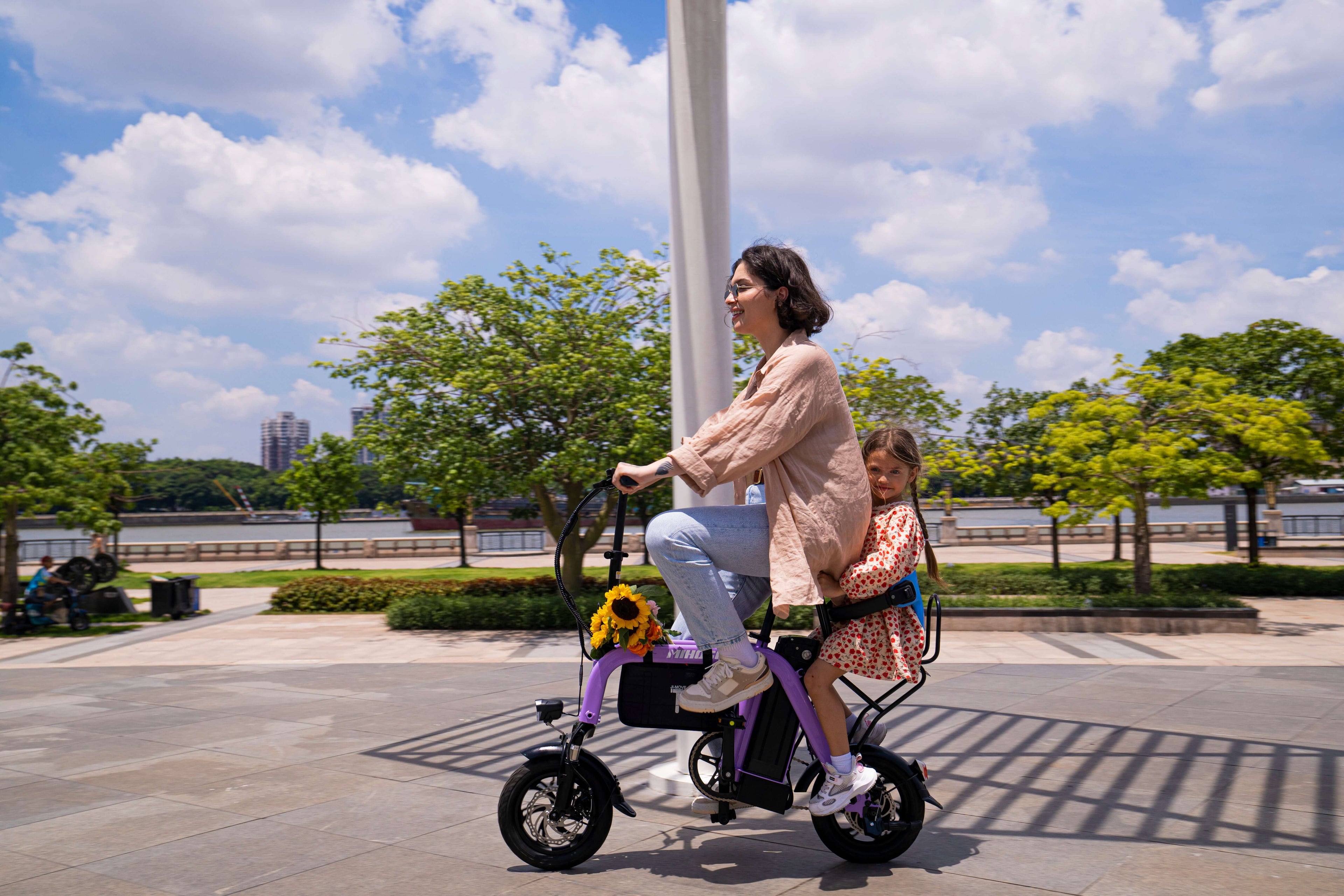Motor efficiency directly impacts every aspect of your riding experience: range per charge, climbing ability, power delivery consistency, and overall system longevity. The global e-bike market projected to grow at a CAGR of 10.3% from 2025 to 2030 means understanding these metrics puts you ahead of the curve in maximizing your Mihogo's value.
Understanding Motor Efficiency Fundamentals
Motor efficiency represents the ratio of mechanical power output to electrical power input, expressed as a percentage. For Mihogo e-bikes, this translates to how effectively your motor converts battery energy into forward motion. Higher efficiency means more miles per charge, reduced heat generation, and extended component life.
The relationship between the drive motor torque and the road-load that is exerted on the rear wheel depends on several factors, including kinematic inertia effects and friction losses between power transmission elements. Among the factors that influence efficiency, friction losses play a dominant role, while the effects of inertia are insignificant.
Key Performance Metrics for Mihogo Motors
Power-to-Weight Ratio Your Mihogo's motor efficiency starts with understanding its power-to-weight characteristics:
- Mihogo Air750 Max: 750W motor optimized for high-speed efficiency
- MIHOGO ONE Utility: 750W with utility-focused torque delivery
- MIHOGO RX 2.4: 500W balanced for commuter efficiency
- Mihogo Mini: 350W maximized for urban performance
Torque Curves and Efficiency Windows Each Mihogo motor operates most efficiently within specific RPM ranges. The motor efficiency is highest at speeds somewhere between specific operating parameters, with lower speeds typically showing reduced efficiency.
Professional Motor Testing Methodology
Real-World Performance Testing Protocol
Equipment Required:
- Digital multimeter for voltage/current measurement
- GPS device for speed and distance tracking
- Battery capacity monitor
- Environmental sensors (temperature, humidity)
- Stopwatch for timing consistency
- Calibrated scale for weight verification
Testing Environment Setup: Establish consistent testing conditions to ensure repeatable results. Temperature affects motor efficiency significantly, with optimal performance typically occurring around 20°C. For meaningful comparisons, conduct all tests under similar environmental conditions.
The Mihogo Efficiency Test Sequence
Phase 1: Baseline Power Consumption Begin with fully charged batteries on level terrain. Record ambient temperature, rider weight, and tire pressure. Maintain consistent speed for each test segment to establish baseline consumption rates.
Phase 2: Load Testing Protocol Gradually increase resistance through:
- Incline variations (2%, 5%, 8%, 12% grades)
- Speed consistency testing (15 mph, 20 mph, 25 mph)
- Different assist levels (Eco, Normal, Sport modes)
- Payload variations (rider only, with cargo)
Phase 3: Efficiency Mapping Create comprehensive efficiency maps showing optimal operating windows for your specific Mihogo model. Track Wh/mile consumption across various conditions to identify peak efficiency zones.
Advanced Diagnostic Techniques
Power Train Efficiency Analysis
The efficiency of electric bicycle power train systems consisting of typical components, such as an electric motor, gears, sprockets, and chains requires systematic evaluation. For Mihogo's hub and mid-drive systems, efficiency varies based on transmission configuration and operating conditions.
Hub Motor Efficiency (Mihogo RX 2.4, Mini) Hub motors deliver power directly to the wheel, eliminating drivetrain losses but creating efficiency variations based on wheel speed. Monitor these key metrics:
- Direct power transfer efficiency (85-95% typical)
- Heat generation during sustained operation
- Speed-dependent efficiency curves
- Rolling resistance impact on overall system efficiency
Mid-Drive Motor Efficiency (Air750 Max, ONE Utility) Mid-drive systems leverage existing bike gears for optimal efficiency across varied terrain. Key testing areas include:
- Gear ratio optimization for different speeds
- Chain drive efficiency (typically 95-98%)
- Motor controller efficiency under varying loads
- Integration efficiency with pedal input
Controller and Battery Integration Testing
Controller Efficiency Metrics The motor controller significantly impacts overall system efficiency. Modern controllers use PWM (Pulse Width Modulation) to regulate power delivery, with efficiency typically ranging from 90-96%.
Battery Discharge Characteristics Monitor battery voltage curves under load to understand how power delivery affects motor efficiency. Lithium-ion batteries maintain relatively stable voltage until near depletion, ensuring consistent motor performance throughout most of the discharge cycle.
Specialized Testing for Each Mihogo Model
Mihogo Air750 Max - Carbon Fiber Performance Testing
The Air750 Max's 750W motor and carbon fiber construction require specific testing protocols:
High-Speed Efficiency Assessment
- Sustained 25 mph efficiency measurements
- Aerodynamic impact on power consumption
- Carbon frame stiffness effects on power transfer
- Long-range efficiency (100+ mile testing)
Performance Optimization Metrics
- Power delivery consistency at maximum assist
- Thermal management during extended climbs
- Integration efficiency with 121-mile range system
MIHOGO ONE Utility - Heavy-Load Performance
The ONE Utility's 750W motor designed for utility work demands specialized testing:
Load Carrying Efficiency
- Efficiency with maximum cargo capacity
- Performance degradation under sustained loads
- Motor cooling effectiveness during work cycles
- Range impact with varying payload configurations
Utility-Specific Metrics
- Start-stop efficiency for delivery scenarios
- Low-speed torque delivery efficiency
- Extended range testing (167-mile capability verification)
MIHOGO RX 2.4 - Commuter Optimization
The RX 2.4's 500W motor optimized for daily commuting requires specific testing approaches:
Urban Efficiency Protocol
- Stop-and-go traffic simulation
- Folding mechanism impact on motor performance
- Compact design thermal management
- 40-mile range verification under commuter conditions
Commuter-Specific Metrics
- Acceleration efficiency from stops
- Maintaining speed efficiency in traffic
- Motor responsiveness in pedal-assist modes
Mihogo Mini - Urban Efficiency Maximization
The Mini's 350W motor demands precision testing for urban optimization:
Compact Motor Efficiency
- Maximum efficiency extraction from 350W
- Urban obstacle navigation power requirements
- Thermal management in compact housing
- 62-mile range optimization strategies
Urban Performance Metrics
- Efficiency in frequent acceleration scenarios
- Power delivery smoothness at low speeds
- Battery optimization for city riding patterns
Data Collection and Analysis
Professional Monitoring Equipment
Real-Time Data Acquisition Use cycling computers with power meter capabilities to track:
- Instantaneous power consumption
- Average efficiency over specific segments
- Peak power demands during acceleration
- Regenerative braking effectiveness (where applicable)
Environmental Data Logging Monitor environmental conditions that affect efficiency:
- Ambient temperature impact on motor performance
- Humidity effects on electrical systems
- Wind resistance calculations for range predictions
- Altitude effects on motor load requirements
Creating Efficiency Profiles
Personal Riding Profile Development Develop individual efficiency profiles based on:
- Typical riding routes and conditions
- Personal riding style and assist level preferences
- Seasonal efficiency variations
- Long-term efficiency trends and degradation patterns
Comparative Analysis Methodology Compare your Mihogo's performance against:
- Manufacturer specifications and claims
- Similar motor configurations in varying conditions
- Efficiency improvements after maintenance or upgrades
- Seasonal performance variations
Optimization Strategies Based on Test Results
Motor Efficiency Enhancement
Mechanical Optimization Based on test results, implement targeted improvements:
- Tire pressure optimization for reduced rolling resistance
- Drivetrain maintenance for maximum power transfer efficiency
- Aerodynamic positioning for reduced power requirements
- Weight optimization for improved power-to-weight ratios
Electronic System Optimization Fine-tune electronic systems for maximum efficiency:
- Controller programming adjustments where applicable
- Battery charging optimization for longevity and performance
- Assist level customization based on efficiency testing
- Regenerative system optimization (if equipped)
Route and Riding Style Optimization
Efficiency-Based Route Planning Use testing data to optimize route selection:
- Identify most efficient speed ranges for your specific Mihogo
- Plan routes that maximize time in peak efficiency zones
- Balance speed vs. efficiency for time-sensitive commutes
- Seasonal route adjustments based on efficiency variations
Riding Technique Refinement Develop riding techniques that maximize motor efficiency:
- Optimal pedal input for hybrid power delivery
- Timing of assist level changes for maximum efficiency
- Acceleration and deceleration patterns that minimize energy waste
- E-bike riding techniques for advanced optimization
Troubleshooting Efficiency Issues
Common Efficiency Problems
Identifying Performance Degradation Watch for these indicators of declining motor efficiency:
- Reduced range compared to baseline measurements
- Increased battery consumption for familiar routes
- Motor running warmer than normal during operation
- Inconsistent power delivery or unusual noise
Systematic Diagnosis Protocol When efficiency problems arise:
- Baseline Comparison: Compare current performance against initial test data
- Component Isolation: Test individual system components (motor, controller, battery)
- Environmental Verification: Ensure testing conditions match baseline parameters
- Progressive Testing: Gradually increase complexity to isolate issues
Professional Maintenance Impact
Maintenance-Related Efficiency Gains Regular maintenance significantly impacts motor efficiency:
- Clean electrical connections for optimal power transfer
- Proper lubrication reduces mechanical friction losses
- Tire maintenance optimizes rolling resistance
- Battery maintenance ensures consistent power delivery
Motor maintenance schedules should be based on efficiency testing results rather than arbitrary time intervals.
Advanced Motor Technologies and Future Testing
Emerging Efficiency Technologies
Smart Motor Systems Modern e-bike motors increasingly incorporate AI-driven efficiency optimization:
- Adaptive power delivery based on riding patterns
- Predictive efficiency adjustments for route conditions
- Real-time optimization of assist levels for maximum range
- Integration with smartphone apps for efficiency tracking
Next-Generation Testing Requirements As motor technology evolves, testing methodologies must advance:
- Software-based efficiency monitoring and reporting
- Integration with IoT sensors for comprehensive data collection
- Machine learning algorithms for personalized efficiency optimization
- Cloud-based performance comparison and benchmarking
Integration with Smart City Infrastructure
Connected Efficiency Optimization Future Mihogo models may integrate with smart city systems:
- Traffic light timing optimization for efficiency
- Real-time route adjustments based on efficiency data
- Integration with charging infrastructure for optimal energy management
- Smart city integration for comprehensive mobility optimization
Professional Testing Services and DIY Approaches
When to Seek Professional Testing
Complex Diagnostics Professional testing becomes necessary for:
- Warranty claims requiring documented performance data
- Suspected motor controller malfunctions
- Integration issues between motor and battery systems
- Performance optimization beyond DIY capabilities
DIY Testing Limitations While comprehensive DIY testing provides valuable insights, professional equipment offers:
- Precision instrumentation for accurate power measurement
- Controlled environmental testing conditions
- Standardized testing protocols for comparative analysis
- Documentation suitable for warranty or insurance purposes
Building Your Testing Capability
Essential DIY Equipment Start with basic testing equipment and expand based on needs:
- Quality cycling computer with power measurement capability
- Digital multimeter for electrical measurements
- GPS device for accurate speed and distance tracking
- Environmental monitoring for consistent test conditions
Advanced DIY Setup For serious efficiency optimization:
- Power meter pedals for hybrid power measurement
- Thermal imaging for motor temperature monitoring
- Data logging systems for extended testing periods
- Analysis software for comprehensive data interpretation
Efficiency Testing Safety Considerations
Electrical Safety Protocols
High-Voltage Safety Mihogo e-bikes operate at voltages requiring safety precautions:
- Always disconnect power before accessing electrical components
- Use proper safety equipment when measuring electrical parameters
- Ensure testing environment is dry and well-ventilated
- Never attempt to modify sealed motor or controller units
Mechanical Safety During Testing Physical safety during efficiency testing:
- Use appropriate safety gear for all test rides
- Ensure bike is mechanically sound before testing
- Conduct high-power tests in safe, controlled environments
- Have emergency procedures in place for testing failures
Environmental Impact of Testing
Sustainable Testing Practices Minimize environmental impact of efficiency testing:
- Plan efficient test routes to minimize unnecessary travel
- Use renewable energy for battery charging when possible
- Properly dispose of any worn components discovered during testing
- Share efficiency data to help other riders optimize their systems
Motor Efficiency and Regulatory Compliance
Understanding Power Regulations
Legal Power Limits Ensure efficiency testing complies with local regulations:
- Most jurisdictions limit e-bike motor power to 750W (1 HP)
- Speed limits typically restrict motor assistance to 20-28 mph
- Power measurement methodologies may vary by jurisdiction
- Efficiency modifications must not exceed legal power limits
Certification and Documentation Maintain proper documentation of efficiency testing:
- Keep records of modifications and their performance impact
- Ensure any changes maintain safety certifications
- Document efficiency improvements for potential resale value
- Maintain warranty compliance during testing and optimization
Real-World Applications and Case Studies
Commuter Efficiency Optimization
Daily Commute Case Study - MIHOGO RX 2.4 A typical 15-mile daily commute showed efficiency improvements through systematic testing:
- Initial efficiency: 25 Wh/mile average
- Post-optimization efficiency: 18 Wh/mile average
- Range improvement: 28% increase in effective range
- Methodology: Systematic assist level optimization and route refinement
Utility Work Case Study - MIHOGO ONE Utility Commercial delivery service optimization demonstrated:
- Load-carrying efficiency mapping across different payloads
- Route optimization based on efficiency vs. time requirements
- Seasonal efficiency variations and adaptation strategies
- Battery life extension through efficiency-optimized operation
Recreational Riding Optimization
Long-Distance Touring - Mihogo Air750 Max Extended range touring efficiency testing revealed:
- Optimal speed ranges for maximum distance per charge
- Terrain-specific efficiency strategies
- Battery management for multi-day touring
- Performance consistency across varying environmental conditions
Urban Exploration - Mihogo Mini City riding efficiency optimization showed:
- Stop-and-go efficiency maximization techniques
- Traffic navigation power management
- Parking and storage efficiency considerations
- Integration with public transportation for extended range
Data Analysis and Performance Benchmarking
Establishing Performance Baselines
Standardized Testing Conditions Create repeatable testing protocols:
- Consistent rider weight and positioning
- Standardized tire pressure and bike setup
- Controlled environmental conditions where possible
- Documented route profiles for comparative testing
Performance Tracking Methodologies Develop systematic approaches to efficiency monitoring:
- Daily efficiency logs for pattern identification
- Seasonal efficiency tracking for long-term trends
- Component-specific efficiency monitoring
- Integration with health and fitness tracking for comprehensive analysis
Wikipedia: Electric Motor provides comprehensive background on motor efficiency principles that apply to e-bike applications.
Conclusion: Maximizing Your Mihogo's Potential
Professional motor efficiency testing transforms your Mihogo e-bike from a transportation tool into a precisely optimized performance machine. Through systematic testing, analysis, and optimization, riders can extract maximum value from their investment while contributing to the growing body of e-bike performance knowledge.
The efficiency of electric bicycle power train systems continues improving as technology advances, but understanding fundamental testing principles ensures you'll always maximize your Mihogo's potential. Whether you're pushing the boundaries of your Air750 Max's 121-mile range or optimizing your Mini's urban efficiency, comprehensive testing provides the insights needed for peak performance.
Remember that motor efficiency testing is an ongoing process, not a one-time activity. As components age, riding patterns evolve, and technology advances, regular efficiency assessment ensures your Mihogo continues delivering optimal performance throughout its service life.
The future of e-bike technology promises even more sophisticated efficiency optimization capabilities, but the fundamental principles of systematic testing, careful analysis, and thoughtful optimization remain constant. By mastering these techniques today, you're prepared to leverage whatever innovations tomorrow brings to the world of electric mobility.
Your Mihogo represents more than transportation—it's a sophisticated electric vehicle deserving of professional-level optimization. Through dedicated efficiency testing and optimization, you're not just improving your riding experience; you're contributing to the advancement of sustainable transportation technology and helping others discover the full potential of electric mobility.








